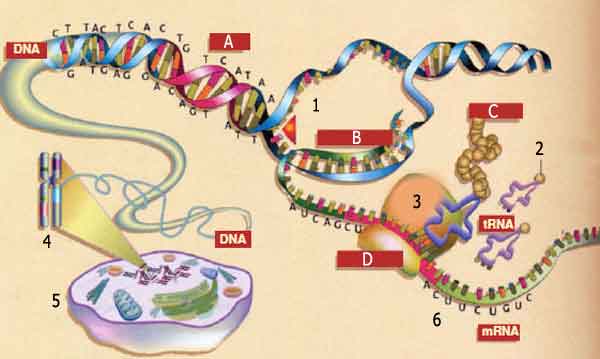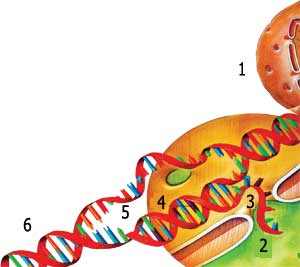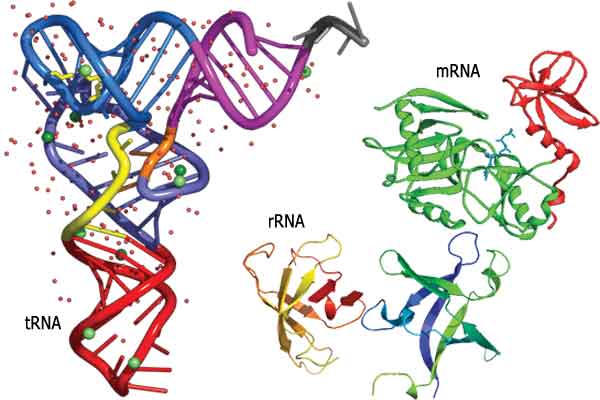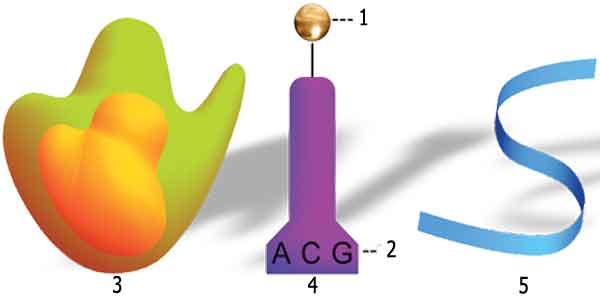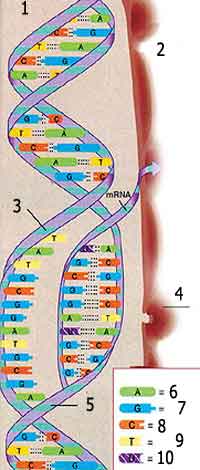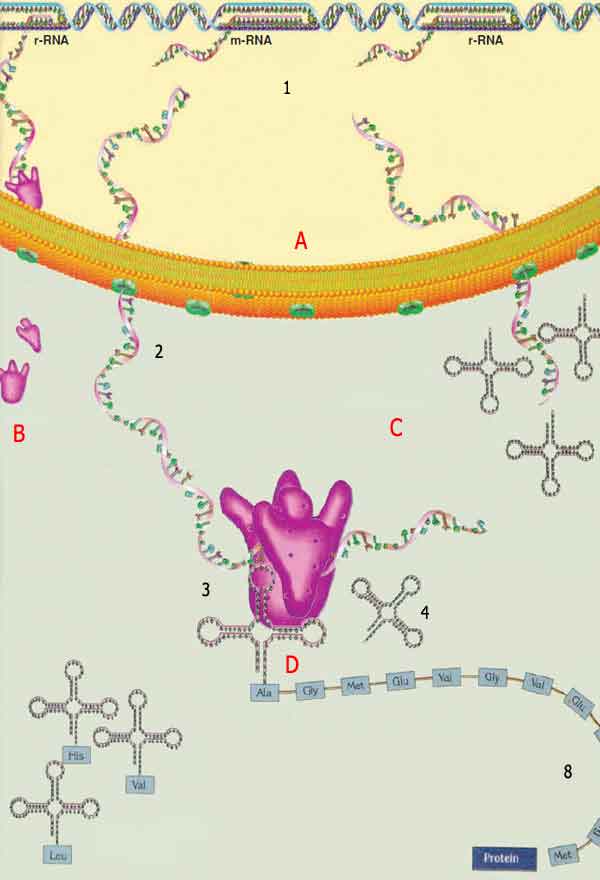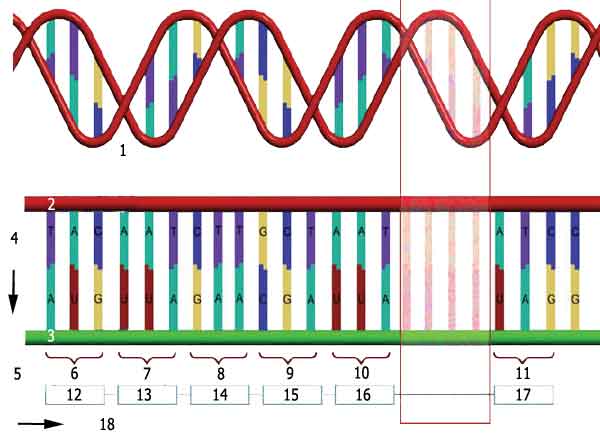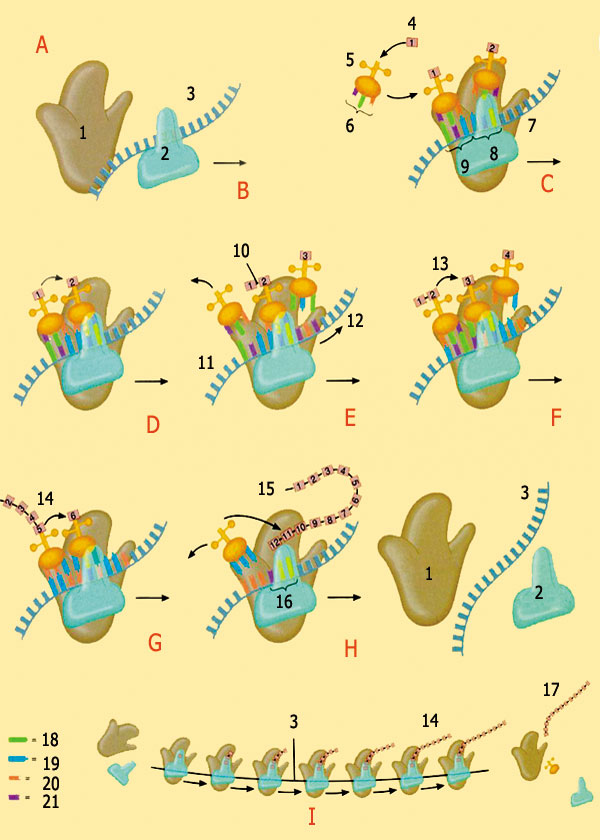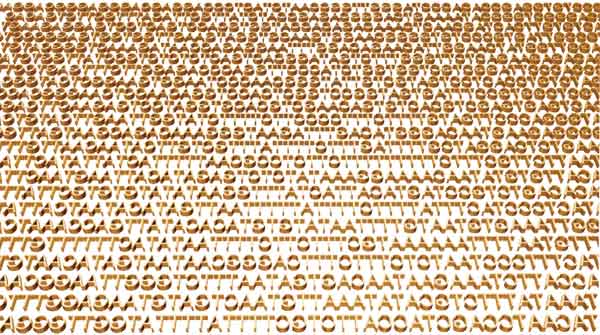Bigotry: The Dark Danger
If Darwin Had Known about DNA

DOWNLOAD THE BOOK
CHAPTERS OF THE BOOK
- From the Depths of the Universe to the DNA Molecule
- The Most Advanced Data Bank Known: DNA
- Aspect of The Cell Discovered In the 20th Century
- The Source of the Data of Life
- The DNA Molecule's Miraculous Structure
- DNA's Extraordinary Data-Storage Capacity
- The Cryptography in the DNA Molecule
- Protein Synthesis: The Matchless Production System Recorded in DNA
- The World's Most Advanced Copying Technology
- The Building Plan Recorded in Human DNA
- Darwinist-Materialist Errors Regarding the Human Genome Project
- The Information in Living Structures and The End of Materialism
- Some of Darwinism's Errors on the Subject of DNA
- How the Miracle of DNA Invalidates the Theory of Evolution
- DNA is an Example of Our Almighty Lord's Creative Artistry
< <
8 / total: 15
Protein Synthesis: The Matchless Production System Recorded in DNAProteins are large, complex molecules that perform a great many essential tasks in the body. The proteins that carry out most of the processes in the cell are essential to the formation of the body's tissues and organs and to those organs' ability to do their own jobs. Proteins consist of hundreds or even thousands of smaller units known as amino acids. Twenty different kinds of amino acid are used to give rise to one protein, and every protein consists of a combination of between three hundred and over a thousand amino acids.73 The arrangement of the amino acids determines proteins' unique three-dimensional structures and functions. Thus every organ uses these proteins specially manufactured for it and operates the systems that keep the individual alive. Inside the human body there are around 200,000 different types of protein, each with its own individual importance. Were the 20 amino acids that comprise proteins to combine together haphazardly, the result would be masses of amino acids in various functionless sequences. Yet these very special arrangements permit proteins to come into existence, essential to human beings' vital functions. Depending on their own particular sequences, proteins are building blocks in the various regions of the body and assume responsibility for different tasks. For example, proteins compose the enzymes that combine to accelerate processes in the body, antibodies that fight disease, and hormones that regulate the functioning of the organs. Each one of these has its own individual, essential importance for the body. Proteins absorbed in food do not work in the body in their existing form. They are first taken into special laboratories in the cell and broken down into smaller molecules- amino acids. Then, these amino acids are recombined in different sequences to constitute whichever of the 200,000 kinds of proteins encoded in DNA is required at any given time. This mechanism, every stage of which is a miracle in its own right, is known as protein synthesis.
Protein synthesis is the main job of the cells, because proteins carry out just about all the work inside cells. Tens of thousands of different kinds of proteins in the human body are repaired when required and replaced with new ones when they grow old. Blueprints inside the genetic information are noted for the production of a new protein, and the required variety is duly manufactured. The production plan for each protein exists in detailed instructions encoded into DNA.
As an individual goes through daily life, just about all the 100 trillion or so cells in the body are carrying out complex processes at every moment. All cells, apart from reproductive and blood cells, produce around 2,000 proteins a second. The approximately 100 trillion cells in an adult human body flawlessly organize some 150,000,000,000,000,000,000 (150 quintillion) amino acids to give rise to protein chains.75 This process goes on every day, every minute, every second. Prof. Gerald L. Schroeder describes this environment inside the cell:
The system for the flawless production of proteins, so vitally important to the survival of living things, is incomparably more complex and organized than any Earthly analogy that could be cited. In this complex production plant, there is no room for the slightest error. Any disruption at any stage is immediately put right by the security system, ensuring that the proteins that permit the organism to remain alive are produced with no disruption, at exactly the right time, and in exactly the right place and form. Another miraculous aspect of protein production is that it occurs at very high speeds. A protein molecule carrying 100 amino acids, for instance, is synthesized by the E. coli bacterium cell in five seconds.77 No factory on Earth is able to complete its entire production process, in a flawless manner, at such a speed. This speed is very important, because several proteins are needed in the cells at any time in order for the organism to survive. In his book The Machinery of Life, the molecular biologist David S. Goodsell expresses the importance to life of protein synthesis:
It is impossible for evolutionists to answer this question, because their Darwinist preconceptions prevent them seeing the facts- or rather, prevents them from openly stating them. The fact is, however, that the fact of creation is inescapable: it is Almighty Allah Who simultaneously creates proteins and the protein synthesis that takes place at great speed inside the cell. Using the coded information in the DNA as a vehicle, our Lord has permitted such vital processes as protein synthesis to continue without interruption. During protein production, many proteins work at the same time. All the required components work flawlessly together inside the cell. More than 80 ribosome proteins, a messenger molecule with more than 20 amino acids, more than a dozen helper enzymes, more than 100 enzymes that carry out the final processes, and 300 macromolecules, more than 40 of them being RNA molecules- all play co-coordinated roles in protein synthesis.79 A large engineering team would have difficulty co-coordinating this impeccable production system. Yet it takes place in a space no larger than 1/1000 millimeter, and the intense activity of hundreds of much smaller molecules permits life to continue. The absence of just one of the molecules involved in the production will disrupt the entire chain. A system that functions in such a planned way and with such evident consciousness is possible only through creation by Allah, the absolute Lord of all things. For a detailed account of how protein synthesis actually takes place, see Harun Yahya, The Miracle of Protein, Araştırma Yayıncılık. This chapter will describe only the general lines of the process as we show how use is made of the information in DNA.
Protein synthesis is carried out in two stages, known as transcription and translation, which permit the information in DNA to be transmitted to RNA, and from there to the proteins. Transcription, the first step, begins in the cell nucleus. The genetic information in the double strip of DNA is to be transported by means of the single-strip RNA molecule. Translation, the final step in protein synthesis, takes place in the cell cytoplasm outside the nucleus, where of the genetic information in RNA is transmitted to new proteins. Let's now look at the general outlines of these stages: The Wisdom Behind DNA and RNA Molecules Being Different
In cells, nucleic acids are found in two separate forms: DNA (short for deoxyribonucleic acid) and RNA (ribonucleic acid), which perform different tasks. The general differences between the two are as follows: Their sugars are different: The backbone of the RNA molecule is ribose sugar, instead of the deoxyribose sugar molecule in DNA. The bases are different: There is uracil (U) in RNA instead of the thymine (T) in DNA. RNA is shorter and consists of just a single strip: RNA is a polymer (a compound formed by a large number of molecules joining together with chemical bonds in a regular manner). It has a structural similarity to DNA and like DNA, it also carries information. But unlike DNA, RNA consists of a single strip. DNA is a more stable molecule: RNA has an extra oxygen atom in every sugar molecule and lacks one carbon atom in every thymine base. The absence of oxygen in DNA's sugar molecules –that is, the fact that DNA has a deoxyribose sugar structure-makes it a more stable molecule than RNA. For that reason, DNA is the ideal molecule for information storage and is far better suited to the long– term storage of data in the cell. Indeed, it is DNA's task to carry information that ensures the survival of the organism and the continuation of subsequent generations. The RNA molecule plays temporary roles and serves in the short-term carrying of information. 80 RNA enters into reactions faster: In addition, since RNA has an extra hydroxyl (OH) group, it enters into reactions more easily than DNA, but which also makes it less stable. This is why RNA is not as well suited as DNA for storing information. Thanks to the way that the single-strip RNA molecule can adapt to complex three-dimensional structures, it's able to engage in catalytic activities that the strong and double-striped DNA helix cannot perform. (A catalytic effect enables a substance to undergo no change, but to effect in a chemical reaction or the speed at which it does so.) Thanks to their catalytic abilities, RNA molecules can alter chemical structures in a most astonishing manner. For example, during the processes in the cell nucleus, they turn a large copy of the DNA sequence into a "messenger RNA" sequence much smaller than themselves. The ribosome then converts messenger RNA into the protein's amino acid sequence.81 The information in DNA can be reached more easily: If the RNA molecule had a double-helix structure like that of DNA, the structural folds in RNA would not occur, which would prevent its being recognized by proteins. Also a double-helix structure would give, RNA with a deep recess, making it harder for proteins to reach it and for its coded information to be read.82 Proteins could not recognize a double-helix RNA and its base sequences as easily as they do with DNA. Therefore, DNA is better suited for containing genetic information because it is more stable and more easily reached.83 DNA and RNA are the ideal molecules for their own separate tasks. RNA carries the genetic message it receives from the DNA inside the nucleus to the cytoplasm (that part of the cell that lies outside the nucleus), where the message is translated. The essential differences between these two molecules help them perform their separate tasks. DNA is a stable and approachable data-preservation center inside the cell, while RNA is a variable carrier that enables genetic information to be translated. In his book Nature's Destiny, the molecular biologist Michael Denton notes the importance of these properties:
RNA, with its single strip, is much more flexible than DNA's double helix. As you see, both the DNA and RNA molecules have been specially created for their own functions. The differences in their structures may seem very minor, but are actually exceedingly important in terms of the jobs they perform, and all these details form a highly complex organization. Prof. Gerald L. Schroeder refers to the complexity in the DNA-RNA mechanism:
No human being has any influence on this system. Our Almighty Lord installed this system, too small to be seen with the naked eye, while the individual was still no more than one single cell. Human beings, enfolded by the mercy of Allah, stand in need of Him in all things: Say: "He is Allah, Absolute Oneness, Allah, the Everlasting Sustainer of all. He has not given birth and was not born. And no one is comparable to Him." (Surat al-Ikhlas, 1-4) Protein Production According to the Instructions in DNA
Whenever the body needs any kind of protein, a message expressing that need reaches the DNA of the cell where that production is to be performed. There is a very important point here which needs to be borne in mind: when there is a need for any kind of protein in the body it is again certain messenger proteins know where they have to apply, are able to locate those sites in the entire body, and forward the message there in readable form. The protein enabling this communication finds it way without becoming lost in the dark interior of the bloodstream, and deposits its message without any part of it being lost or damaged. In short, we are looking at a considerable awareness and sense of responsibility. The message reaching the cell nucleus forms the protein as the result of a series of complex and highly organized processes. The way that the demand for protein reaches the correct cells out of all the 100 trillion other cells in the body, how the cells understand what is required of them and immediately goes to work, and produce a perfect result are all phenomena that amaze scientists. The genetic code in the DNA molecule is so programmed that only the cell itself is capable of knowing its content, its meaning, and how it will affect the body throughout its lifetime. However, these cells are merely masses of unconscious inanimate atoms. Under the direction of our Almighty Lord, Who regulates all things on the Earth and in the skies, processes that human beings are unable to carry out are performed in a perfect manner. In the Qur'an, Allah reveals that: [Hud said,] "I have put my trust in Allah, my Lord and your Lord. There is no creature He does not hold by the forelock. My Lord is on a Straight Path.' (Surah Hud, 56) It is Allah Who created the seven heavens and of the Earth the same number, the Command descending down through all of them, so that you might know that Allah has power over all things and that Allah encompasses all things in His knowledge. (Surat at-Talaq, 12) Protein molecules are produced in blocks, in much the same way that a house is built by bricks placed on top of one another. Every different protein is manufactured according to a specific blueprint. The particular amino acid sequence of each protein is determined according to the data recorded in the DNA. The deciphering of the DNA's genetic code, and protein production based on that information, take place in two main stages:
1- The synthesis of RNA from DNA (transcription):The first stage in protein production is the synthesis of RNA. This process begins with the opening of the DNA helix. The bases adenine, guanine, cytosine and thymine opposite one another in the DNA molecule combine in such a way as to join the two backbones and give rise to a helical structure. During the transcription phase, these bases let go of one another and the double helix of the DNA molecule begins separating, just like the two sides of a zipper. As the DNA begins to unravel, a special protein known as RNA polymerase begins reading the DNA by traveling along it. During the course of this reading, new RNA is produced by the successive addition of the corresponding bases. This RNA being manufactured is messenger RNA (mRNA). The difference between mRNA and DNA is that instead of the base adenine being opposite thymine, a base known as uracil (represented by the letter U, for short) does so. These bases are arranged in groups of three. The messenger RNA, whose production is now complete, is then subjected to a series of processes and separated from the DNA. In much the same way that a sculptor adjusts carved a statue right down to the finest detail, the cell directs a string of enzymes to adjust the crude RNA produced. 2- The synthesis of protein from RNA (translation):The messenger RNA, whose adjustment processes completed, emerges from the nucleus and bonds an organelle known as the ribosome, the cell's energy-production plant. One feature of the messenger RNA molecule is that its bases are set out in groups of three, known as codons. The reading of these three-part groups begins after mRNA has bonded to the ribosome. Another variety of RNA known as transporter RNA (Trna) which, during protein synthesis carry the amino acids that will make up the new proteins. Unlike the messenger RNA or DNA molecules, transporter RNA is not long, with only 15 to 20 base sequences. Also, its consecutive bases are bonded in such a way as to form a circle. There are two important regions in the transporter RNA link. The first is the region that permits recognition of the amino acids it will transport; the other region, known as the anti-codon, is consists of three bases that will attach to the mRNA.
The anti-codon in the transporter RNA attaches to the triple groups known as codons on the mRNA bonded to the ribosome. One after the other, the transporter RNA anti-codons bond to the codons on the messenger RNA and also bring with them amino acids. As the transporter RNAs attach to the codons, the attached amino acids begin bonding to one another. When hundreds or thousands of tRNAs are lined up alongside one another, the amino acids they bear are also lined up side by side and begin protein synthesis by constructing bonds with one another. At that point, the tRNA, whose work is done and that has discharged its load, breaks the bond with the mRNA and separates from the ribosome.
During production, one single amino acid being added in the wrong place is enough to make a functionless protein molecule. Yet this process is carried out in a flawless manner in all living things. Every tRNA molecule serves as a transporter, carrying every amino acid to the predetermined site and ensuring that there is no impairment in the process. The molecular biologist Michael Denton notes this extraordinary organization:
These actions –requiring immaculate discipline, awareness and responsibility– are a sign that these unconscious molecules have submitted to Omniscient and Almighty Allah and that they behave under His control. In one verse of the Qur'an it is revealed that: Say: "I seek refuge with the Lord of humanity, the King of humanity, the deity of humanity." (Surat an-Nas, 1-3)
An Evident Miracle: Proteins Perform Protein SynthesisIn the different stages of protein synthesis, hundreds of different proteins and enzymes are needed for the manufacture of a single protein molecule. In addition, a great many molecules and ions (electrically charged atoms) are ready and waiting. That being so, the question of how the first protein came into being represents one of the most severe difficulties facing evolutionists. In an article published in American Scientist magazine, the evolutionist and biologist Carly P. Haskings expresses their predicament:
As this scientist states, in order for protein synthesis to occur, all the systems in the cell need to be present at once. The absence of even one component of the system will mean that proteins cannot be manufactured and that therefore, life cannot continue. Evolutionists, however, claim that proteins first emerged as the result of chance, and that cells then formed as a result of random combinations of proteins. However, it is perfectly obvious that none of these components can form in the absence of the others. This is clear proof that Allah has created all living things together with all their systems. His flawless creation is revealed in these terms in the Qur'an: He is Allah-the Creator, the Maker, the Giver of Form. To Him belong the Most Beautiful Names. Everything in the heavens and Earth glorifies Him. He is the Almighty, the All-Wise. (Surat al-Hashr, 24) Since the molecules in question are made up of unconscious atoms, how can a substance devoid of intellect or consciousness possess the abilities to regulate and control something else, and to intervene in processes? How can it send instructions, acting in a systematic manner in line with a specific objective? People who fall under the influence of Darwinist teachings claim that all these things are the work of blind coincidence. However, it is impossible for molecules, unaware of the presence of cells, to take upon themselves the responsibility of producing the needed proteins they need. It is quite impossible for unconscious atoms to accomplish the various tasks requiring the superior intelligence, knowledge and awareness. All they do is to flawlessly perform the task set out for them, and have submitted to Allah, Who imposes this task on them and Who has created them as part of this system. In one verse of the Qur'an it is revealed that: [Moses said,] "Your deity is Allah alone, there is no deity but Him. He encompasses all things in His knowledge."' (Surah Ta Ha, 98)
Footnotes73. Gerald L. Schroeder, The Hidden Face of God, p. 189. 74. Michael J. Denton, Nature's Destiny,p. 172. 75. Gerald L. Schroeder, The Hidden Face of God, p 189. 76. Ibid., p. 216. 77. Albert L. Lehninger, David L. Nelson, Michael M. Cox, Principles of Biochemistry, 2. baskı, Worth Publishers, 1993, New York, p. 892. 78. David S. Goodsell, The Machinery of Life, p. 45. (emphasis added). 79. Albert L. Lehninger, David L. Nelson, Michael M. Cox, Principles of Biochemistry, p. 892. 80. David S. Goodsell, The Machinery of Life, p. 17. 81. Michael J. Denton, Nature's Destiny, p. 158. 82. Ibid., p. 157. 83. Ibid. 84. Ibid., p. 159. 85. Gerald L. Schroeder, The Hidden Face of God, pp.. 67-68. 86. Michael J. Denton, Nature's Destiny, p. 417. 87. Carly P. Haskings, "Advances and Challenges in Science", American Scientist,Vol. 59, 1971, p. 298 (emphasis added).
|
||||||||||||||||||||||||||||||||||||||||||||||||||||||||||||||||||||||||||||||
8 / total 15
You can read Harun Yahya's book If Darwin Had Known about DNA online, share it on social networks such as Facebook and Twitter, download it to your computer, use it in your homework and theses, and publish, copy or reproduce it on your own web sites or blogs without paying any copyright fee, so long as you acknowledge this site as the reference.
